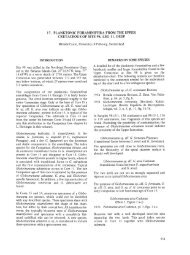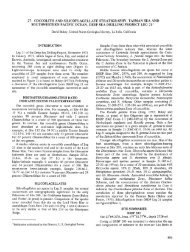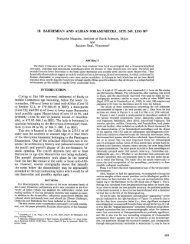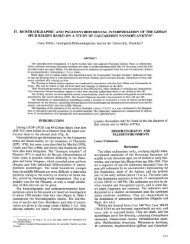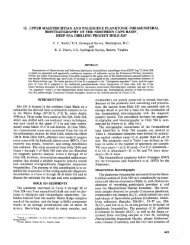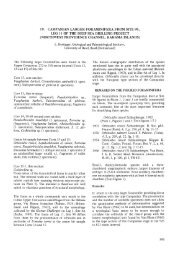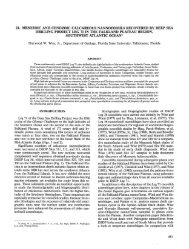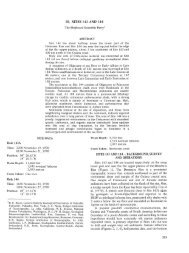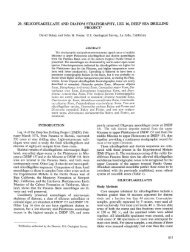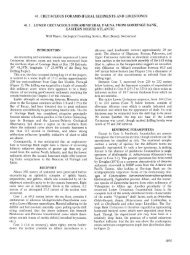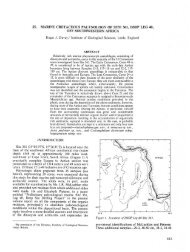16. Radiolaria - Deep Sea Drilling Project
16. Radiolaria - Deep Sea Drilling Project
16. Radiolaria - Deep Sea Drilling Project
You also want an ePaper? Increase the reach of your titles
YUMPU automatically turns print PDFs into web optimized ePapers that Google loves.
M. G. PETRUSHEVSKAYA, G. E. KOZLOVA<br />
Sample<br />
1A-2, 12-14 cm<br />
1A-2, 78-80 cm<br />
1A-3, 5-7 cm<br />
1A-3, 76-78 cm<br />
1A-4, 5-7 cm<br />
1A-4, 80-82 cm<br />
1A-5, 5-7 cm<br />
1A-CC<br />
2A-4, 5-7 cm<br />
2A-5, 5-7 cm<br />
2A-5, 80-82 cm<br />
2A-6, 2-4 cm<br />
1-2, MID<br />
1-3, 80-85 cm<br />
1-4<br />
1-5, 80-85 cm<br />
1-6, 80-85 cm<br />
1-CC<br />
2-1, TOP<br />
2-1<br />
2-2, TOP<br />
2-3<br />
2-CC<br />
Abundance<br />
1 1 1 1 1 1 1 1 1 1 1 1<br />
1 1 1 1<br />
—<br />
| 1 I 1 1 1<br />
Preservation<br />
g<br />
m<br />
m<br />
m<br />
m<br />
P<br />
m<br />
m<br />
m<br />
m<br />
m<br />
m<br />
g<br />
g<br />
g<br />
g<br />
g<br />
g<br />
p/g<br />
m/g<br />
P/m<br />
p/g<br />
p/m<br />
TABLE 12<br />
<strong>Radiolaria</strong>ns at Holes 144 and 144A<br />
Lithochytris sp. A<br />
Desmospyris sp. aff. D. lata<br />
Pterocanium ? satelles<br />
Plectodiscus circularis<br />
Eusyringium striata<br />
Lithocampium sp. A<br />
Becoma bidarfensis<br />
Podocyrtis argulus<br />
Podocyrtis papalis<br />
Theocampe mongolfieri<br />
Periphaena decora<br />
Dendrospyris didiceros group<br />
Eusyringium fistuligerum<br />
Calocycloma ampulla<br />
Lampterium chalara<br />
Anthocyrtella spatiosa group<br />
Stylatractus coronatus<br />
Heliodiscus hexasteriscus<br />
Heliodiscus pentasteriscus<br />
Porodiscus concentricus<br />
Lithochytris sp. 0<br />
Lithochytris sp. T<br />
Astractinium aristotelis<br />
Trigonactinium pithagorae<br />
Tholodiscus splendens<br />
Lophophaena capito group<br />
Lithocyclia ocellus sens. str.<br />
Thyrsocyrtis triacantha<br />
Theocampe sp. aff. T. gemmata<br />
Eucyrtidium sp. aff. E. montiparum |<br />
1 1 1 1 \ 1 1 1 1 1 1 1<br />
1 1 1 1<br />
—<br />
R<br />
R<br />
-<br />
-<br />
-<br />
-<br />
R<br />
OS 1<br />
-<br />
-<br />
-<br />
F<br />
F<br />
-<br />
-<br />
-<br />
C<br />
A C<br />
F<br />
-<br />
-<br />
-<br />
C<br />
F<br />
-<br />
-<br />
-<br />
C<br />
C<br />
c<br />
-<br />
-<br />
-<br />
R<br />
F<br />
F<br />
-<br />
-<br />
-<br />
R<br />
-<br />
T)<br />
R<br />
R<br />
R<br />
R<br />
o o o o<br />
six. It differs from Echinomma leptodermum in shape and number<br />
of the pores, in the number of spines, and in the dimensions of the<br />
third shell.<br />
From the Cannartus petterssoni Zone till Recent. Earlier forms<br />
of that very type existed, but they differ from the species in<br />
question by having a thicker, heavier third shell with smaller pores.<br />
516<br />
c<br />
R<br />
p<br />
p<br />
p<br />
b b 1 b A<br />
A<br />
A<br />
A<br />
A<br />
C<br />
OS OS C R<br />
T7<br />
F<br />
R<br />
R<br />
R<br />
C<br />
C<br />
c c<br />
c c<br />
c<br />
A<br />
JO JO<br />
R<br />
-<br />
-<br />
C<br />
c<br />
—<br />
JO JO<br />
-<br />
F<br />
p<br />
R<br />
R<br />
C<br />
C<br />
C<br />
C<br />
A<br />
F<br />
R<br />
R<br />
R<br />
R<br />
R<br />
Tj Tj Tj Tj<br />
F<br />
C<br />
Tj Tj<br />
F<br />
-<br />
A<br />
A<br />
A<br />
A<br />
A C<br />
A A<br />
R<br />
-<br />
o o o o<br />
-<br />
-<br />
b b b b<br />
Tj Tj<br />
T7<br />
-<br />
I I I I<br />
C<br />
-<br />
-<br />
1 1 1 1<br />
C<br />
-<br />
-<br />
-<br />
R<br />
R<br />
R<br />
R<br />
JO JO<br />
-<br />
-<br />
-<br />
o o o n<br />
o o o o<br />
c<br />
c<br />
-<br />
R<br />
R<br />
-<br />
c<br />
C<br />
-<br />
R<br />
R<br />
F<br />
F<br />
R<br />
1 1 1 1<br />
A<br />
p<br />
R<br />
-<br />
p<br />
-<br />
1 1 1 1 _<br />
-<br />
R<br />
A<br />
C F<br />
-<br />
R R<br />
R R<br />
C R<br />
C R<br />
C R<br />
C R<br />
c<br />
c<br />
R R<br />
F<br />
F<br />
p<br />
R<br />
R<br />
p<br />
r<br />
r<br />
F<br />
-<br />
R<br />
R<br />
R<br />
o o o n<br />
c<br />
A<br />
I 1 1 1 jo<br />
p<br />
p<br />
C<br />
R<br />
R<br />
R<br />
C<br />
C<br />
C<br />
C<br />
c<br />
A<br />
F<br />
R<br />
F<br />
-<br />
-<br />
1 1 OS OS b b b b C<br />
| 1 1 1 1<br />
Genus HALIOMETTA Haeckel, emend.<br />
-<br />
-<br />
JO JO JO<br />
n n n n<br />
Haliometta Haeckel, 1887, p. 233; Campbell, 1954, p. 62. Type<br />
species Haliomma circumtextum (Haeckel, 1887, pi. 28, fig. 7).<br />
The test consists of three (rarely four) shells. The first is<br />
irregular, about 20 µ in diameter. The first and second (so-called<br />
A<br />
A<br />
F



